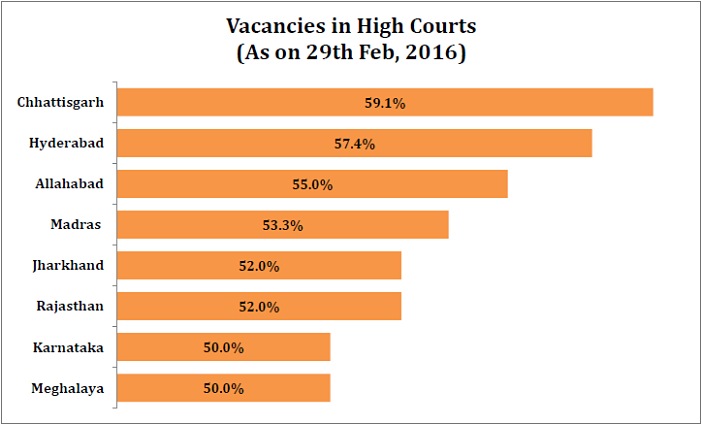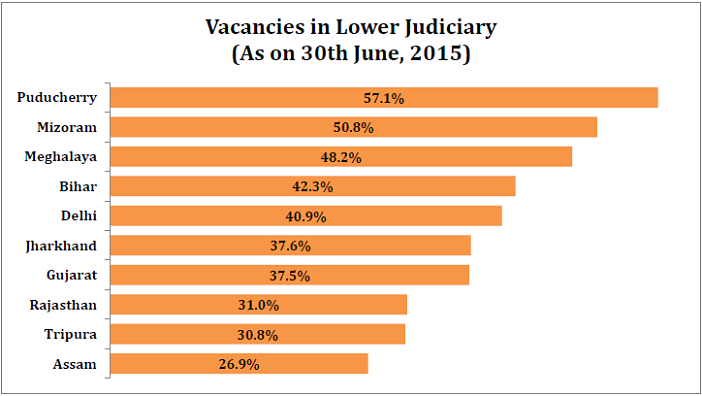[orc]The huge pendency of cases in Indian Courts is a known fact. One of the prime reasons for such pendency is large number of vacancies in courts. According to Government figures, there are 44% vacancies in High Courts and 25% vacancies in lower courts compared to the sanctioned strength. Even with the sanctioned strength, India only has one-third of the judges it requires.
As Factly reported earlier, there is huge pendency of cases at all levels of Judiciary. Large number of Vacancies both in the High Courts and lower judiciary is one of the prime reasons for increasing pendency. Government data indicates that there are 44% vacancies in the High Courts and around 25% in the lower judiciary across the country.
44% Vacancies in High Courts
Against an approved strength of 31, the Supreme Court has 25 judges with 6 vacancies as of 29th February, 2016. In the 24 different High Courts of the country, there are 464 vacancies against an approved strength of 1056, which are 44% vacancies.

Within the states, Chhattisgarh High Court has close to 60% vacancies followed by the High Court at Hyderabad with 57.4% vacancies. The High Courts in Allahabad, Madras, Jharkhand, Rajasthan, Karnataka and Meghalaya have more than 50% vacancies. Percentage of vacancies in 13 of the 24 High Courts is more than the national average of 44%. Only Tripura High Court is working at full strength of 4 Judges. Of the bigger states, Kerala High Court has only 8% vacancies. Only 5 of the 24 High Courts have less than 30% vacancies.
In absolute numbers, Allahabad High Court has a shortfall of 88 judges followed by Madras High Court with 40 vacancies. 11 of the 24 High Courts have more than 20 vacancies each.
Only 35 Judges were appointed from January to April 2015
A total of 35 Judges were appointed to the Supreme Court & High Courts from January 2015 to 13th April, 2015. These appointments were made through the Collegium process. On 13th April 2015, the National Judicial Appointments Commission Act was brought into force and hence all further appointments through the Collegium process were frozen.
The Supreme Court, in October 2015 declared that the system of appointment of Judges to Supreme Court and the High Courts can be made only through the Collegium system and struck down the National Judicial Appointments Commission Act. The Supreme Court also decided to consider new measures for an improved working of the Collegium System.
The Government then submitted its suggestions and maintained that the Parliament has the power to lay down the criteria and the process for appointment of Judges.
The Supreme Court pronounced its final order in December 2015 and asked the government to finalise the Memorandum of Procedure for appointments to higher judiciary. The Court also directed the government to include parameters like eligibility criteria, transparency in the appointment process, Secretariat and complaints etc in the procedure. In the meantime, with the revival of the Collegium system, the process of appointment of Judges has resumed.
25% Vacancies in the Lower Judiciary
Against a total sanctioned strength of 20358, there are 4998 vacancies in the lower judiciary (District & Subordinate courts) as on 30th June, 2015. In other words, almost a quarter of the posts are vacant. Puducherry has the highest percentage of vacancies with 57.1% followed by Mizoram, Meghalaya, Bihar and Delhi in the top five. 9 of the 33 States/UTs have more than 30% vacancies while in 15 of the 33 States/UTs, percentage of vacancies is more than the national average. Chandigarh & Lakshadweep have no vacancies in the lower judiciary. Of the larger states, Kerala has only 8% vacancies.

India needs three times the current Sanctioned Strength of Judges
In the All India Judges’ Association Case, the Supreme Court directed that there should be 50 judges for a million people in the country. This was based on a comparative assessment of the position in other countries. Even the Law Commission in its 120th Report recommended that the strength of judges per million should be increased to 50.
Based on the 2011 census and the sanctioned strength of various courts in the country, the Judge Population ratio in the country is about 17.72 Judges per million people. This is almost 1/3rd of what both the Supreme Court and the Law Commission suggested. The three fold increase in the sanctioned strength looks like a distant dream when one looks at the existing vacancies.
Featured Image: [Featured Image via Wikimedia, CC BY 3.0]


